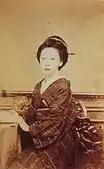Narasaki Ryō
Narasaki Ryō (楢崎 龍, July 23, 1841 – January 15, 1906) was a Japanese woman and the wife of Sakamoto Ryōma, an architect of the Meiji Restoration. She is commonly called Oryō (お龍) in Japan. After the death of her first husband, she married the merchant Nishimura Matsubē and was renamed to Nishimura Tsuru (西村 ツル).
Narasaki Ryō | |||||
|---|---|---|---|---|---|
楢崎 龍 | |||||
 Narasaki Ryō in her later years | |||||
| Born | July 23, 1841 Kyoto, Japan | ||||
| Died | January 15, 1906 (aged 64) | ||||
| Resting place | Shigaraki-ji, Ōtsu, Yokosuka, Kanagawa Prefecture, Japan | ||||
| Nationality | Japanese | ||||
| Other names | Oryō (お龍) Nishimura Tsuru (西村 ツル) | ||||
| Known for | saved the life of her husband Sakamoto Ryōma and his bodyguard by running semi-naked through the inn to his room to warn them of the assassins' arrival during the Teradaya incident in 1866 | ||||
| Spouses | |||||
| Parents |
| ||||
| Relatives |
| ||||
| Japanese name | |||||
| Kanji | 楢崎 龍 | ||||
| Hiragana | ならさき りょう | ||||
| Katakana | ナラサキ リョウ | ||||
| |||||
Early life
She was born in Kyoto on July 23, 1841, as the eldest daughter of the physician Narasaki Shōsaku and his wife Shigeno Sada. She had two younger sisters Narasaki Mitsue (later Nakazawa Mitsue) and Narasaki Kimi (later Sugeno Kimi), and two younger brothers Narasaki Taichirō and Narasaki Kenkichi. Her father was arrested and went to prison during the Ansei Purge. He died after being released from prison when she was 21 years old.
Oryō married Sakamoto Ryōma in 1864.
Teradaya Incident
Oryō is best known for saving the life of her husband Sakamoto Ryōma from an assassination attempt during the Teradaya Incident.[1] She worked at Kyoto's Teradaya Inn, and while taking a bath in the evening on March 9, 1866, heard one of the assassins outside, who immediately thrust his spear through the bathroom window right by her shoulder. She grabbed the spear with one hand and confronted him in a loud voice. She then quickly jumped out of the bathtub and, putting on her robe without a sash, ran out into a garden and went up the second floor of the inn to warn Sakamoto, who was in his room with his bodyguard Miyoshi Shinzo.[2] Sakamoto and Miyoshi soon fought their way out and escaped with slight injuries.
Sakamoto's injuries during the attacks led them to visit several hot springs in Kagoshima Prefecture that were believed to have healing properties, in what has been said to be the first Japanese honeymoon.[3]
Later years and death
Oryō was widowed after Sakamoto Ryōma's assassination during the Ōmiya incident on December 10, 1867. She married the merchant Nishimura Matsubē (西村松兵衛) in 1875 and took the name of Nishimura Tsuru (西村 ツル). She later adopted her sister's child, who died young.[4]
In her later years, Oryō suffered from alcoholism.[5] Despite the fame of her first husband, Oryō died in poverty on January 15, 1906, at the age of 64. She was buried at Shigaraki-ji, Ōtsu, Yokosuka, in Kanagawa Prefecture. Eight years later, with assistance from Mitsuaki Tanaka and Kagawa Keizō, and her younger sister Nakazawa Mitsue, her widower Nishimura Matsubē and his colleagues managed to erect a tombstone for her in August 1914.
Gallery
 Narasaki Ryō as a young woman.
Narasaki Ryō as a young woman.
 Sakamoto Ryōma and Narasaki Ryō wedding venue's stone stele marker in Kyoto
Sakamoto Ryōma and Narasaki Ryō wedding venue's stone stele marker in Kyoto Narasaki family's former residence stone stele marker in Kyoto
Narasaki family's former residence stone stele marker in Kyoto
References
- "History and romance at Teradaya, Kyoto". Retrieved 5 February 2018.
- "寺田屋事件", Wikipedia (in Japanese), 2021-08-17, retrieved 2022-01-14
- "【歴史】日本初の新婚旅行は坂本龍馬ではなく、小松帯刀(たてわき)? 通説"龍馬"に異論登場". mamono.2ch.net. Retrieved 5 February 2018.
- 松兵衛の除籍簿写に「楢崎て以(貞)ノ孫入籍 養嗣子松之助 明治七年八月十五日生」とある。鈴木かほる『史料が語る 坂本龍馬の妻お龍』p128-131
- 阿井景子『龍馬と八人の女性』p196-197、p200
External links
 Media related to Narasaki Ryo at Wikimedia Commons
Media related to Narasaki Ryo at Wikimedia Commons